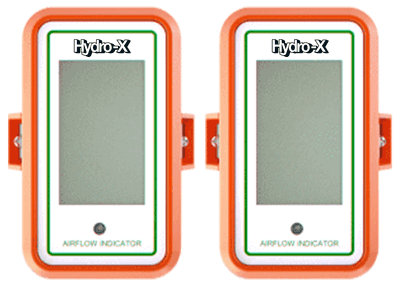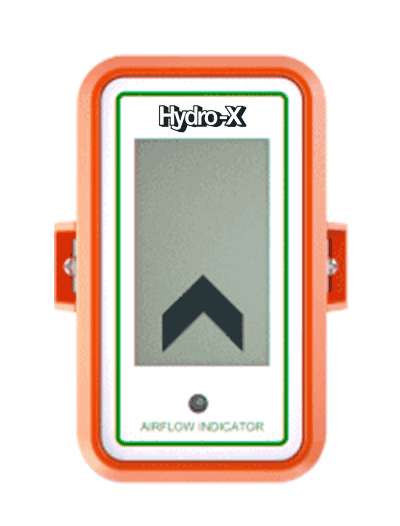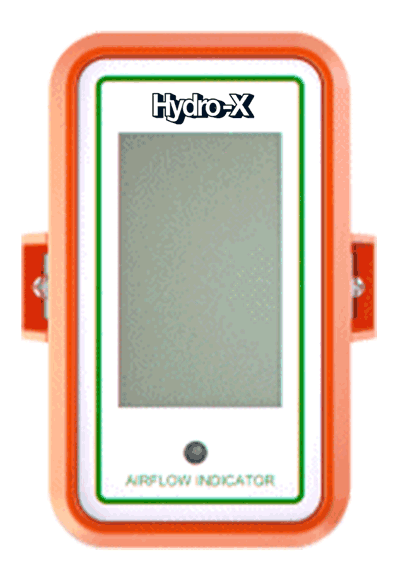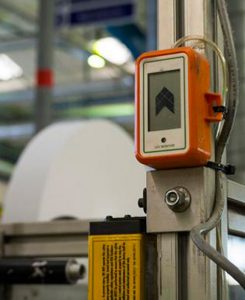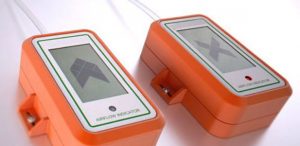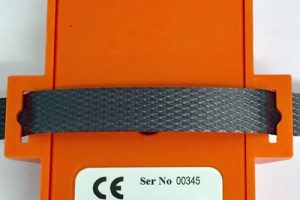LEV Air Flow Indicator (HSG258 Compliant)
HSE’s HSG258 Guidance Document; Paragraph 106
Benefits of Our LEV Indicator
- HSG258 Compliant: Operating at pressures from 100 Pa to 2,000 Pa.
- Easy To Install: Weighs only 130g. Can be installed up to 10m away. Can be installed on the duct or a nearby surface using banding, self-tapping screws, etc.
- Easy To Calibrate: Unlike analogue air flow gauges, our lev airflow indicator self-calibrates to the pressures inside your ducts. A simple calibration procedure is all that is required.
- Easy To Use: Our LEV indicator is bright orange so users can easily identify the unit. As a result, users can confidently check for adequate air flow thanks to the continuously flashing display, or flashing red light if there is insufficient airflow.
- Cost-Effective: Because our LEV Airflow Indicator can be recalibrated, if your system changes (such as adding new hoods), you can recalibrate the unit quickly and easily as often as you like to the new static pressure. This can save you the cost of replacing.
- Manufactured In The UK
£93.50 (ex VAT)
Standard Delivery 1-2 Working Days
Do I Need To Fit Air Flow Indicators To LEV Systems?
The HSE (Health and Safety Executive) recommends that air flow indicators are fitted to all LEVs (Local Exhaust Ventilation Systems). This is to ensure the LEV airflow indicators continue to work properly, in providing a clear sign when the air flow is adequate. This is recommended in the HSE’s HSG258 Guidelines (Controlling Airborne Contaminants at Work: A Guide To Local Exhaust Ventilation LEVs).
LEV airflow indicators should also follow guidelines in COSHH 2002 (Control of Substances Hazardous to Health) Regulation 9. This legislation states that all LEV extraction systems must be maintained in efficient working order.
Many people die or are disabled permanently after they breathe in airborne contaminants at their workplace. LEV is one of the devices that can help in controlling airborne contaminants. It is therefore a legal requirement for employers to ensure that LEV systems are working properly. Therefore, LEV Airflow Indicators are an effective and efficient way of identifying this.
Why Choose Our HSG258 Compliant, LEV Airflow Indicator?
There are several different types of LEV Airflow Indicators, sometimes called:
- Local Exhaust Ventilation Monitors
- LEV Monitors
- LEV Air Flow Indicator
- Air Flow Meters
- Digital Manometers
- LEV Indicators
- Manometers
- Pressure Gauges.
 Good Air Flow
Good Air Flow
All these indictors essentially do the same job. However, historically each meter or gauge only works for specific situations, at specific pressures, such as 0-750Pa or 0-1,500Pa. Additionally, if the system changes, then the gauge no longer works and you would have to buy another. Furthermore, analogue devices are also mechanical in nature. This means they can frequently fail, especially when subjected to vibrations, which LEV systems generate a lot of.
Our chevron air flow indicator also continuously monitors air flow, so as soon as a user starts to use an LEV system, they will see clearly and easily whether the LEV is safe to use or not. If air flow is insufficient, our LEV Airflow Indicator will clearly show a ‘cross’ sign on the display, and flash a red light to alert the user. It also gives the operator a simple indication that the hood is working properly.
With a battery life of at least 14 months, easily replace the 2 x AA batteries during routine inspection to guarantee continued tamper-proof operation and examination and testing.
How Do I Fit the Air Flow Indicator?
To fit our LEV air flow indicator, it can be mounted directly onto the duct itself using the hand strapping and buckle supplied. Otherwise, you can fit it by self-tapping screws, or nuts and bolts. Alternatively, you can easily extend the tube using the supplied adaptor.
The chevron air flow indicator can be placed up to 10 metres away. And it will work just as well!
How Does the LEV Indicator Work?
Our LEV Airflow Indicator monitors the static pressure in the extract duct.
The sample tube from the indicator is fitted to the extract duct, close to the point of extract. This should be done using an extended grommet or tapped hose tail.
After the airflow indictor is installed using the provided magnetic actuator, calibration will take under 10 seconds.
The indictor samples the negative static pressure in the duct every 15 seconds. The display will update accordingly.
The lev indictor will show the static pressure in the duct is safe and the airflow is adequate. This will display an arrow continuously moving forward.
If the negative static pressure within the duct drops by more than 20%, the air flow indictor recognises this as an unsafe condition. This triggers a series of LED flashes below the chevron display, after which the display flashes a cross symbol.
 Poor Air Flow
Poor Air Flow
Guidance On Calibrating
Once installed, the chevron air flow indicator will be uniquely calibrated to the air flow of the LEV system. Therefore, it is important that the LEV system is working correctly to ensure correct calibration. As a result, the best and safest time to install the LEV air flow indicator is after an LEV assessment has been conducted. The assessment should show the LEV system is in full working order.

